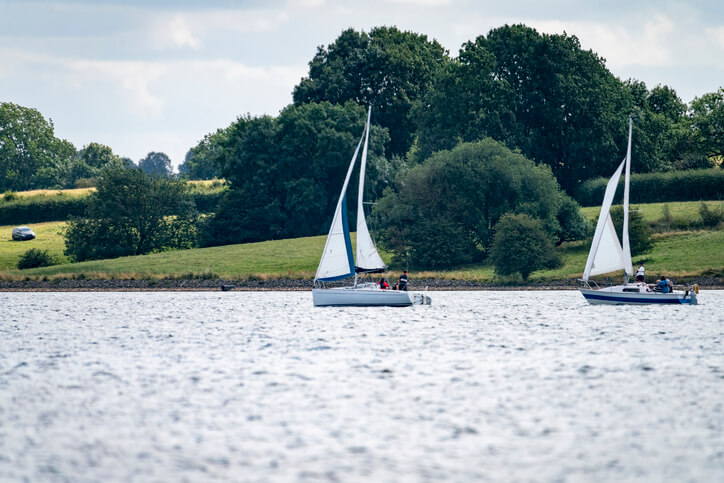Learning to sail: The basics
25 July 2025

Learning to sail is an exciting experience and creates the opportunity for endless adventures out on the water. Whether you own a sailboat, yacht, or dinghy, learning how to sail it carefully and knowledgeably will keep all trips safe and enjoyable.
In this guide, we share why you should learn and the basics of how to sail. We’ll also look at what you need to get started and tips for learning safely and quickly.
Why learn to sail?
Sailing is a fun, rewarding activity that’s perfect for anyone who loves seeking adventure and learning new skills.
You’ll have a unique opportunity to connect with nature as you explore the seas – you really can’t beat the sense of freedom that comes with sailing. Plus, it also enhances many transferable skills, like teambuilding and navigation.
Whether you’re planning on sailing locally, dreaming of longer trips or hoping to live aboard your sailboat during holidays, learning how to sail safely and efficiently comes with lots of amazing opportunities.
How hard is it to learn to sail?
As with all new skills, learning to sail requires focus and effort. However, it isn’t necessarily hard to learn if you’re committed to putting in the work. Through a combination of reading, classroom learning, and getting out onto the water, you’ll quickly get to grips with the basics of sailing and can improve your skills from there.
Understanding sailing terms is often one of the most difficult parts, as this activity has its own unique language. From the different parts of the sailboat to the words used for various manoeuvres, sailing is a hobby that is guaranteed to expand your vocabulary.
The basics of how to sail
Understanding the basics can help you to learn safely and quickly. Here’s what you should do.
- Familiarise yourself with sailing terminology, the parts of your sailboat, yacht, or dinghy, and basic manoeuvres (such as those in our list of dinghy racing tips)
- Take an RYA training course for beginners to gain important skills and knowledge
- Join a sailing club where you’ll be able to access sailboats and equipment, in addition to getting the opportunity to chat with experienced sailors
- Gain an understanding of how to thoroughly check weather and tide information to ensure safe sailing
- Carry important safety equipment, including a lifejacket or buoyancy aid, flares, and a VHF radio
What you need to start learning to sail
To learn to sail in the UK, you don’t need a licence to sail a pleasure boat unless it has an engine. You also won’t need any prior sailing experience to take a training course, and you can register with no sailing knowledge at all – although it can help to have a basic understanding of different terms before you start. A Royal Yachting Association (RYA) qualification is a great option for beginners and is sometimes required when sailing abroad.
When it comes to learning to sail safely, you’ll need a lifejacket or buoyancy aid, clothing that’s suitable for the weather conditions, and suitable footwear that will provide grip while sailing. Other items to consider purchasing include a dry bag to keep your valuables safe while on the water, gloves to protect your hands, and a whistle for attracting attention.
Ways to learn sailing as a beginner
You can learn to sail as a beginner by teaching yourself or attending a sailing school. While learning how to sail through watching videos, reading books, and taking online courses can be appropriate for some people, having in-person training will ensure you are doing everything properly. It can also alleviate nerves and will likely get you confidently out on the water quicker than if you were to teach yourself.
The best way to find a suitable sailing school is to search the RYA’s directory for recognised options. When choosing somewhere to learn to sail, think about where it is easy to get to, the type of yachts or sailboats you’d like to focus on, and whether you’re interested in group or solo lessons. Cost can also be an important consideration, so have your budget in mind before committing to a particular sailing school.
Common beginner sailing mistakes to avoid
Making mistakes as a beginner is all part of learning the ropes out on the water, and understanding common sailing mistakes can help you to avoid making these yourself.
Not checking the weather
Bad weather, including heavy rain and strong winds, can have a very negative impact on your sailing experience, especially when you’re still learning. Always check the weather forecast via a reliable source, such as the MET Office, before heading out onto the water. Our tips for safely boating in a storm may also be useful.
Being overconfident
Learning something new is exciting, which can make it easy to become overconfident and start pushing yourself beyond your limits. Start slowly with short trips and let your confidence build gradually over time to ensure safe, enjoyable sailing experiences.
Ignoring safety guidelines
No matter how confident you are in the water, following sailing safety rules is vital so you, your crew, and any other passengers return safely to dry land. Wear a lifejacket or buoyancy aid and always familiarise yourself with the safety equipment on your particular vessel.
Poor communication
One of the most important parts of sailing is good communication. Making sure your crew knows their different roles and what is expected of them is integral every time you set sail. Poor communication leads to confusion, errors, and could result in accidents, making it a common mistake to avoid for all sailors.
Using only electronic navigation
While using technology can make things easier, beginner sailors need to learn how to navigate using traditional charts and compasses. Technology can potentially fail, lose signal or break while at sea, and not having another form of navigation could mean you get lost or are unable to sail safely.
Tips for learning to sail quickly and safely
Follow these tips when you first start sailing, and you’ll pick it up in no time.
- Find an RYA-recognised sailing school to learn from knowledgeable professionals
- Always prioritise safety and wear a lifejacket or buoyancy aid while out on the water
- Learn on a small to medium-sized boat that will help you get a feel for its movements
- Sail in light winds and calm waters to gain an understanding of how the boat responds
- Label different parts of your sailboat while you get used to the terms you’ll need to use
- Always check the weather forecast and let someone know where you plan to sail
- Practice basic manoeuvres until they become second nature
- Relax, have fun, and enjoy learning a new and exciting skill set
Specialist boat insurance through Craftinsure
You may want to consider yacht or dinghy insurance to protect your investment when you’re learning how to sail.
Specialist boat insurance through Craftinsure provides up to £5m third-party cover and protects your boat against loss or damage from fire or theft. Get an instant online quote today.
Please note the information provided on this page should not be taken as advice and has been written as a matter of opinion. For more on insurance cover and policy wording, see our homepage.


